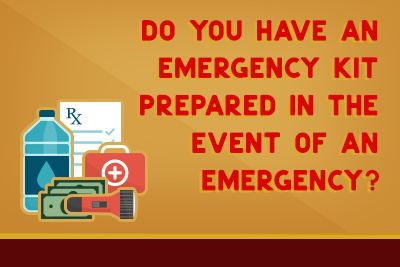
Disasters can happen at any moment, and unfortunately, older adults are among the most vulnerable when a disaster occurs. Limitations in vision and mobility can make moving around more difficult. Planning ahead will help avoid long waits to get supplies and help make a smoother transition to safety.
When it comes to preparing your Emergency Disaster Kit, there are 3 steps to follow: create an emergency plan, stock an emergency medical kit, and make a supplies kit.
Step 1 : Create an Emergency Plan
- Have an emergency communication plan: prepare a group text/call plan. Make sure to have someone to initially call in the event of an emergency who will be the one who passes the information onto others.
- Keep updated contacts
- Make travel arrangements: talk to your friends and family about what to do in the event you do have to evacuate. Make sure to have a clear plan about who is responsible for picking them up, where to meet and at what time.
- Get local emergency information: have your community or disaster relief hotline on hand. These disaster relief groups will work with you to find the best place to evacuate and give you information if you are in need of any medical attention.
- Practice: go over your emergency plan with a mock-disaster drill to practice exactly what you would have to do in that situation.
Step 2 : Stock an Emergency Medical Kit
It’s recommended to include these in your emergency medical kit:
- Medications: pack about a weeks worth, just to make sure you have enough.
- Medical equipment: if you need a blood sugar monitor, blood pressure cuff, hearing aids or anything of the sort, make sure to pack them! It’s also a good idea to pack an extra set of glasses/contacts and dentures.
- Written Letter about Medications and Treatment: ask for copies of your medical records, especially if you're currently under treatment and always pack an extra copy of any insurance card.
Step 3 : Make a Disaster Supplies Kit
This kit should also include your emergency medical kit listed above.
- Water: a good rule of thumb is to keep 1 gallon per person per day.
- Food: at least a 3 day supply is good to keep, and make sure you pack foods that wont spoil, like canned foods.
- Basic Supplies: pack supplies such as a flashlight, batteries, knife, reusable plastic bags, and charger.
- Change of clothing
- Cash: at least $50 in the event that the banks and ATMs are not working.
- First aid kit
- Basic hygiene products
It’s always best to be safe than sorry when it comes to making emergency kits, you never know when disaster will strike.
View more disaster prep tips here.
Source: https://www.healthinaging.org/tools-and-tips/emergency-preparedness-older-adults

